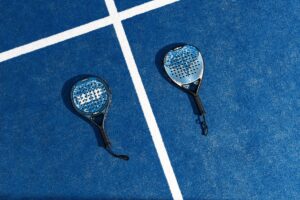The Fundamentals of Padel: What You Need to Know
3 min read
The Fundamentals of Padel: What You Need to Know
Padel is a thrilling sport that has taken the world by storm. But what is padel? Simply put, padel is a racquet sport that is played on a court that is smaller than a tennis court. It’s a fun and exciting game that is easy to learn, but hard to master. If you’re starting out with padel, here are the fundamentals that you need to know.
The Court
A padel court is 20 meters long and 10 meters wide, which is about a third of the size of a tennis court. The court is enclosed by glass walls and metal fencing, which means that balls can be played off the walls during rallies. The court is divided in two, with a net in the middle. Like in tennis, the aim of the game is to hit the ball into your opponent’s half of the court without them being able to return the shot.
The Equipment
To play padel, you’ll need a padel racquet, which is similar in shape to a tennis racquet but is smaller and has a lower string tension. You’ll also need a padel ball, which is similar to a tennis ball but is slightly smaller and softer. Padel shoes are important, too – you want shoes that are designed for the court surface, which is usually artificial grass or a hard surface.
The Basic Rules
Padel is played in doubles, with each team consisting of two players. The server starts the game by serving underhand from behind the baseline. If the ball hits the net and still goes over, it’s a valid serve. The receiving team must return the serve after letting the ball bounce once on their side of the court. After the serve, players can hit the ball off the walls during rallies, making for some exciting and unpredictable shots! A point is won if the other team fails to return the ball, hits it out of bounds, or commits a fault.
The Strategy
While padel is a fast-paced game, strategy is just as important as speed and accuracy. The first thing to remember is to communicate well with your partner – calling out your intentions and movements can help your team move as a unit. Positioning is important, too – you want to keep to your own side of the court as much as possible, and aim for shots that keep the other team off balance. And remember, sometimes the best shot is not always the hardest – a well-placed shot can win you just as many points as a powerful one.
The Conclusion
Now that you know the fundamentals of padel, it’s time to get out there and try it for yourself. This fun and exciting sport is easy to learn, but takes practice to master. Whether you’re a seasoned athlete or a complete beginner, padel is a great way to get some exercise while having fun. So grab your racquet and get ready to conquer the court – who knows, you might just become the next padel superstar!






